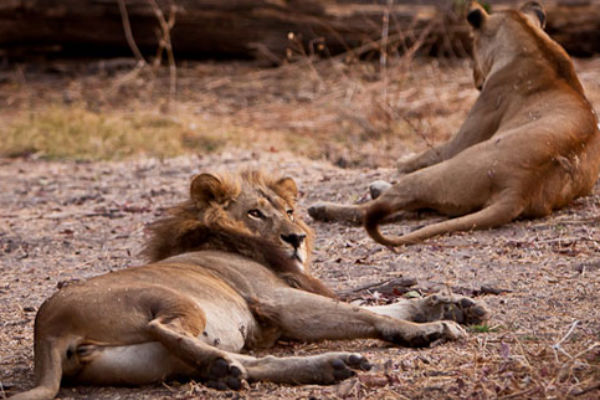Why do these lionesses in Botswana have manes?
There’s a place called Mombo in Botswana’s Moremi Game Reserve
that houses some very peculiar lionesses. These female lions are maned -
and that doesn’t mean just a few tufts of hair around their necks and
chests - their manes are so luxurious, they can often fool competing
lions into thinking they’re males.
While there are just a handful of these maned lionesses in Mombo, they’re a regular sight for the locals, and researchers suspect that this population carries a genetic disposition towards the highly unusual trait.
According to Christine Dell’Amore at National Geographic, it’s thought that these ‘masculine’ females are born from embryos whose development has been compromised either at the point of conception, or while they’re forming in the womb.
“If the former case, the genetic contribution of the sperm - which determines the sex of the foetus in most mammals - was probably aberrant, giving rise to a female with some male characteristics,” Luke Hunter, president of the big-cat conservation group Panthera, told Dell’Amore. “Alternatively and perhaps more likely, the problem may have occurred during gestation if the foetus was exposed to increased levels of androgens— male hormones, such as testosterone.”
 The ‘masculinisation’ of a female offspring due to high levels of
androgens in the mother during pregnancy is occasionally seen in humans,
but it’s far more rare in wild animals. Unfortunately the disorder
often leaves the female lions infertile, but it doesn’t seem to have
affected their chances of survival, particularly if they already belong
to a pride. In fact, while they are treated as females within their own
prides, outside their family group they are thought of as males, which
appears to make it easier for them to fend off hyenas and rival males.
The ‘masculinisation’ of a female offspring due to high levels of
androgens in the mother during pregnancy is occasionally seen in humans,
but it’s far more rare in wild animals. Unfortunately the disorder
often leaves the female lions infertile, but it doesn’t seem to have
affected their chances of survival, particularly if they already belong
to a pride. In fact, while they are treated as females within their own
prides, outside their family group they are thought of as males, which
appears to make it easier for them to fend off hyenas and rival males.
“It would be interesting to know if she behaved like a male,” said Hunter to Dell’Amore at National Geographic of the maned female in the image above. “Two similarly aberrant Serengeti lionesses were outwardly female - they did not have manes, but were almost male-sized, and they challenged and fought unfamiliar males for territories as though they were males!”
This phenomenon can also occur in captivity - in 2011, a 13-year-old lioness named Emma at the National Zoological Gardens of South Africa began growing a stunning, honey-coloured mane. Concerned that her levels of testosterone were too high, the keepers removed her ovaries and took skin biopsy samples to figure out the cause.
While her biopsy showed that she had normal female XX chromosomes, her ovaries revealed something very different. "Surprisingly, the ‘ovaries' that were removed only contained cells normally seen in the testicles of males. This was obviously where the testosterone was being produced,” said the zoo’s clinical veterinarian, Adrian Tordiffe, in a press release. "After her ovaries were removed, Emma gradually lost her mane hair and returned to her normal female good looks."
Source: http://www.sciencealert.com
While there are just a handful of these maned lionesses in Mombo, they’re a regular sight for the locals, and researchers suspect that this population carries a genetic disposition towards the highly unusual trait.
According to Christine Dell’Amore at National Geographic, it’s thought that these ‘masculine’ females are born from embryos whose development has been compromised either at the point of conception, or while they’re forming in the womb.
“If the former case, the genetic contribution of the sperm - which determines the sex of the foetus in most mammals - was probably aberrant, giving rise to a female with some male characteristics,” Luke Hunter, president of the big-cat conservation group Panthera, told Dell’Amore. “Alternatively and perhaps more likely, the problem may have occurred during gestation if the foetus was exposed to increased levels of androgens— male hormones, such as testosterone.”

Image: Ryan Green
“It would be interesting to know if she behaved like a male,” said Hunter to Dell’Amore at National Geographic of the maned female in the image above. “Two similarly aberrant Serengeti lionesses were outwardly female - they did not have manes, but were almost male-sized, and they challenged and fought unfamiliar males for territories as though they were males!”
This phenomenon can also occur in captivity - in 2011, a 13-year-old lioness named Emma at the National Zoological Gardens of South Africa began growing a stunning, honey-coloured mane. Concerned that her levels of testosterone were too high, the keepers removed her ovaries and took skin biopsy samples to figure out the cause.
While her biopsy showed that she had normal female XX chromosomes, her ovaries revealed something very different. "Surprisingly, the ‘ovaries' that were removed only contained cells normally seen in the testicles of males. This was obviously where the testosterone was being produced,” said the zoo’s clinical veterinarian, Adrian Tordiffe, in a press release. "After her ovaries were removed, Emma gradually lost her mane hair and returned to her normal female good looks."
Source: http://www.sciencealert.com
Σχόλια
Δημοσίευση σχολίου